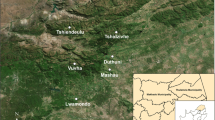Abstract
Factors in Maintaining Indigenous Knowledge among Ethnic Communities of Manus Island. Economic Botany 59(4):356-365, 2005. Despite the fact that Manus Province is the most geographically isolated province of Papua New Guinea, research shows that the acculturation process, common among minority indigenous groups around the globe, has had detrimental effects on maintaining knowledge and customs. Analysis of ethnobotanical knowledge among the indigenous population of Manus was undertaken in an attempt to compare, contrast, and draw conclusions regarding factors in maintaining indigenous knowledge of the local flora. Four levels of knowledge (plants recognized, identified, identified as useful, and identified as medicinally useful) were used to examine the relationships between knowledge of the local flora and physical, geographical, and social variables of informants. Results showed significant differences in ethnobotanical knowledge based on informant gender, age, cultural subclass, and habitation locality. Low levels of medicinal plant knowledge were found among the Manus due to acculturation, supporting the theory that medicinal plant knowledge is particularly vulnerable to loss.
Similar content being viewed by others
Literature cited
Alexiades, M. N. 1996. Protocol for conducting ethnobotanical research in the tropics. Advances in Economic Botany 10:5.
Boom, B. M. 1987. Ethnobotany of the Chácobo Indians, Beni, Bolivia. New York Botanical Garden Press, New York.
Caniago, I., and S. F. Siebert. 1998. Medicinal plant ecology, knowledge and conservation in Kalimantan, Indonesia. Economic Botany 52:229–250.
Dennett, G., and J. Connell. 1988. Acculturation and health in the highlands of Papua New Guinea: Dissent on diversity, diets, and development. Current Anthropology 29:273–299.
Farnsworth, N. R., O. Akerele, A. S. Bingel, D. D. Soejarto, and Z. Guo. 1985. Medicinal plants in therapy. Bulletin of the World Health Organization 63:965–981.
Hanazaki, N., J. Y. Tamashiro, H. F. Leitao, and A. Begossi. 2000. Diversity of plant uses in two Caicara communities from the Atlantic Forest coast, Brazil. Biodiversity and Conservation 9: 597–615.
Holdsworth, D., and C. N’Drawii. 1973. Medicinal and poisonous plants from Manus Island. Science in New Guinea 1:11–17.
—,and B. Wamoi. 1982. Medicinal plants of the Admiralty Islands, PNG. International Journal of Crude Drug Research 20:169–181.
Johns, T., J. O. Kokwaro, and E. K. Kimanani. 1990. Herbal remedies of the Luo of Siaya District, Kenya-Establishing quantitative criteria for consensus. Economic Botany 44:369–381.
Kingsbury, N. D. 2001. Impacts of land use and cultural change in a fragile environment: Indigenous acculturation and deforestations in Kavanayen, Gran Sabana, Venezuela. Interciencia 26:10.
Kristensen, M., and H. Balslev. 2003. Perceptions, use and availability of woody plants among the Gourounsi in Burkina Faso. Biodiversity and Conservation 12:1715–1739.
Lewis, W. H. 2003. Pharmaceutical discoveries based on ethnomedicinal plants: 1985 to 2000 and beyond. Economic Botany 57:126–134.
—,and M. P. Elvin-Lewis. 1994. Basic, quantitative and experimental research phases of future ethnobotany with reference to the medicinal-plants of South America. Ethnobotany and the Search for New Drugs 185:60–72.
Luoga, E. J., E. T. F. Witkowski, and K. Balkwill. 2000. Differential utilization and ethnobotany of trees in Kitulanghalo Forest Reserve and surrounding communal lands, Eastern Tanzania. Economic Botany 54:328–343.
Mead, M. 1930. Growing up in New Guinea: A comparative study of primitive education. W. Morrow and Company, New York.
—. 1942. Growing up in New Guinea: A study of adolescence and sex in primitive societies. Penguin Books, Harmondsworth, England.
—. 1963. Sex and temperament in three primitive societies. W. Morrow and Company, New York.
—. 1968. New lives for old: Cultural transformation —Manus, 1928-1953. Dell, NY.
Minol, B. 2000. Manus from the legends to year 2000: A history of the people of Manus. UPNG Press, Port Moresby, Papua New Guinea.
Murray, S. O., and R. Darnell. 2000. Margaret Mead and paradigm shifts within anthropology during the 1920s. Journal of Youth and Adolescence 29:557–573.
Phillips, O., and A. H. Gentry. 1993a. The useful plants of Tambopata, Peru 1. Statistical hypotheses tests with a new quantitative technique. Economic Botany 47:15–32.
—. 1993b. The useful plants of Tambopata, Peru 2. Additional hypothesis-testing in quantitative ethnobotany. Economic Botany 47:33–43.
Roll, B. H., and F. Roll. 1984. Stori bilong Pere: A genealogical and photographic study of Pere Village, Manus Province, Papua New Guinea. B.H. Roll, NY.
Romanucci-Ross, L. 1985. Mead’s other Manus: Phenomenology of the encounter. Bergin and Garvey, South Hadley, MA.
—. 1990. Wage, trade, and exchange in Melanesia: A Manus society in the modern state. American Anthropologist 92:1063–1063.
—,D. E. Moerman, and L. R. Tancredi. 1997. The anthropology of medicine: From culture to method. Bergin and Garvey, Westport, CT.
Romanucci-Schwartz, L. 1969. The hierarchy of resort in curative practices: The Admiralty Islands, Melanesia. Journal of Healthy Social Behavior 10: 201–209.
Satterthwaite, F. W. 1946. An approximate distribution of estimates of variance components. Biometrics Bulletin 2:110–114.
Schultes, R. E. 1994. Amazonian ethnobotany and the search for new drugs. Ethnobotany and the Search for New Drugs 185:106–112.
Stagegaard, J., M. Sorensen, and L. P. Kvist. 2002. Estimations of the importance of plant resources extracted by inhabitants of the Peruvian Amazon flood plains. Perspectives in Plant Ecology Evolution and Systematics 5:103–122.
Sullivan, G. 2004. Margaret Mead: A biography. Journal of the History of the Behavioral Sciences 40: 327–328.
Vandebroek, I., J. B. Calewaert, S. De Jonckheere,S. Sanca, L. Semo, P. Van Damme, L. Van Puyvelde, and N. De Kimpe. 2004. Use of medicinal plants and Pharmaceuticals by indigenous communities in the Bolivian Andes and Amazon. Bulletin of the World Health Organization 82:243–250.
Weiss, E. A. 1979. Some indigenous plants used domestically by East African coastal fishermen. Economic Botany 33:35–51.
WHO. 2002. Traditional medicine—growing needs and potential. WHO Policy and Perspectives on Medicines 2:1–6.
Author information
Authors and Affiliations
Corresponding author
Rights and permissions
About this article
Cite this article
Case, R.J., Pauli, G.F. & Soejarto, D.D. Factors in maintaining indigenous knowledge among ethnic communities of Manus Island. Econ Bot 59, 356–365 (2005). https://doi.org/10.1663/0013-0001(2005)059[0356:FIMIKA]2.0.CO;2
Received:
Accepted:
Issue Date:
DOI: https://doi.org/10.1663/0013-0001(2005)059[0356:FIMIKA]2.0.CO;2




